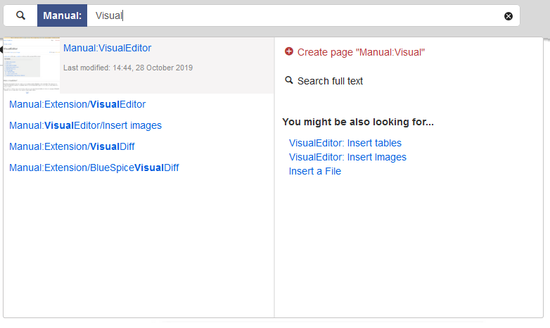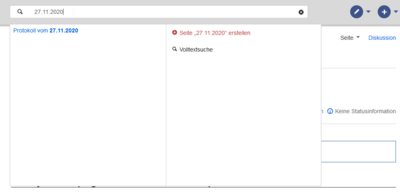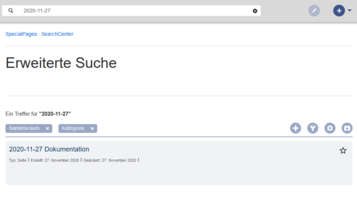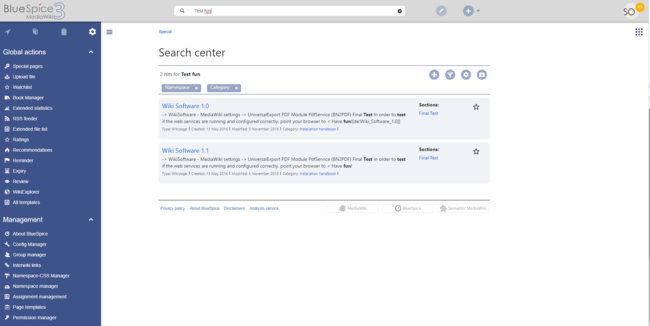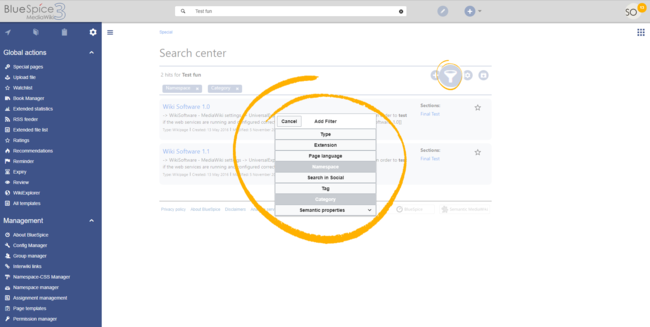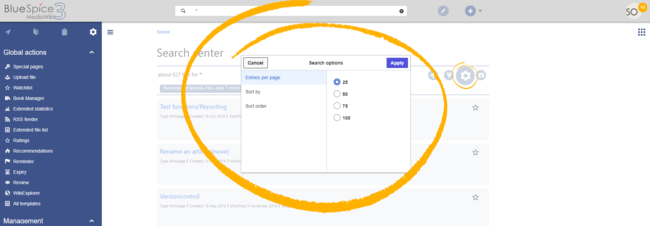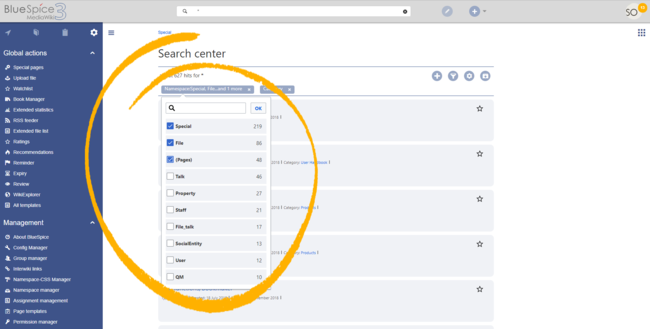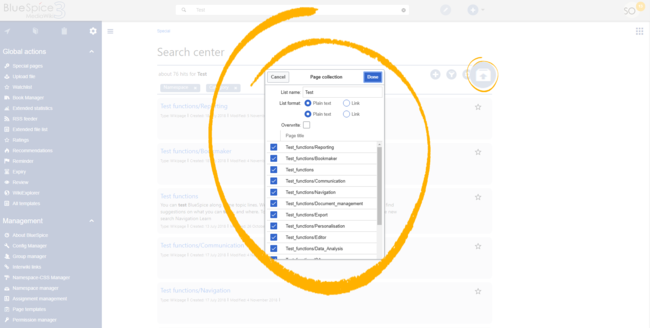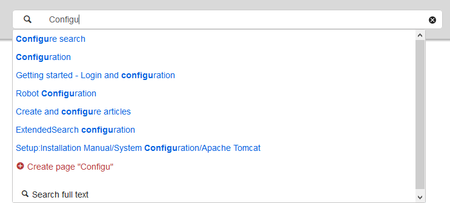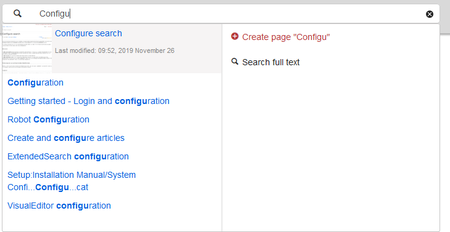Extended search
-
- Last edited 4 years ago by MLR
-
ExtendedSearch replaces the default MediaWiki search engine. It is based on the Elasticsearch engine and provides many improvements over standard MediaWiki search both in terms of quality of indexed content and user interface. Pages and files are indexed immediately and available for searching in real-time.
Contents
Usage
Extended search offers two ways of searching for content:
- Title search using the quick search
- Fulltext search using the search center
By default, the search indexes:
- wiki pages: all content pages, except for pages in the MediaWiki namespace
- special pages: all pages in the namespace Special
- repo files: files uploaded to the wiki - for text files like Word documents and PDFs, this includes content and metadata
- external files: files from arbitrary locations from accessible storage paths (e.g., mounted drives)
- social entities: entities (pages) created by the BlueSpiceSocial extension, like blog posts and user profiles
Autocomplete
The search box in the main toolbar offers with autocomplete functionality is available from any page on the wiki. Autocomplete matches only page and file titles, but does not provide a full-text serach.
After typing in the search bar, an autocomplete popup appears:
This popup is divided in two columns.
Left column:
- Primary results: These are the results that are direct matches for the search term. The exact matches are shown in bold letters.
- When looking for the term "quality management", it is also possible to type in "qual man" and the search starts looking for matches
- The best match is often shown with a thumbnail preview as a top search result
Right column:
- Tools and secondary results: Tools are displayed in the top portion of the right column and contain:
- a button to create the page with the current search term as the title (only if user has permission to create new pages)
- a button to execute full-text search for the current term. Selecting this option leads to the Search Center.
In the bottom portion of the right column, secondary results are displayed. Secondary results are matches that do not directly match the given term, but might be relevant for the user. These show up only in certain contexts:
- If there are significantly more matches for a similar term than the term actually searched for (in a situation of a typo for example)
- If the namespace or subpage pill is present (see next section). In this case, secondary results will show direct matches in other namespaces/pages.
Namespace and subpage "pills"
Autocomplete search bar supports pills for namespaces and subpages.
If a user types Manual:, a pill for the namespace "Manual" appears and the search for the following term is limited to this namespace. .
Subpage pills work in the same way. If the user types in PageName/, any term after that is matched in the context of that page. If you search for "TestPage/Te", for example, the search will match only subpages of "TestPage" that contain "Te" in the title, like "TestPage/Test" and "TestPage/TestSubpage".
Configuration
Previously explained is the full version of the autocomplete popup. Wiki admins can also choose to use "Simple autocomplete", which contains only one column with primary results and tools, without secondary results. This type of autocomplete is also more compact. This setting is available from BlueSpiceConfigManager, under Extension > BlueSpiceExtendedSearch > Use simple autocomplete.
Search operators
Since the autocomplete search only searches for titles, search operators such as AND or OR are not supported. However, they are supported using the Search Center.
Dates as search terms
The search recognizes certain date formats. In the search center, these date formats are treated with surrounding quotation marks.
Search Center (extended search)
As soon as you trigger the full-search with the magnifying glass symbol or the Enter key, the wiki switches to the Search Center. This is a special page that offers the full functionality of the search. The search in the Search Center is carried out using the same search bar that is also used for autocomplete.
Here, the search engine carries out a full text search, which also includes the metadata of documents. It does not index the wikitext of a wiki page, but rather the rendered content, that is the output by the browser.
Search operators
To use search operators in the full-text search, the following syntax can be used:
- Sandbox AND Widgets - returns pages that contain both the term sandbox and the term widgets
- Sandbox OR Widgets - returns pages that contain either the term sandbox or the term widgets.
- (Sandbox) NOT (Widgets) - returns pages that contain the term sandbox but not the term widgets..
The search operators have to be written in uppercase letters.
Elements
- Hit count - shows how many matches a search has returned. It may be exact or approximate. Approximation is due to dynamic check for permissions to view each page in the results, some results may not be shown to the user with no adequeate permissions event if it matches the search term.
- Tools - these are located in the top right as a set of buttons:
- Create a page - represented by a "plus" button - will create a page with current search term as a title (only visible if user has permission to create pages)
- Add filters - represented by a "funnel" icon - opens a dialog where users can select the type of filter to apply to the search.
- Search options - represented by a "gear" icon - opens a dialog where users can change settings for the current search. It provides options like the number of results per page, sorting field and order.
- Export search - represented by the "export" icon - opens a dialog to export current search results to a dedicated page (only visible to authorized users, by default admin users).
- Filter: Filters are displayed in form of pills below the results counter. Each filter pill represents a different attribute. Filter values can be changed by clicking on the filter pill and selecting the desired options from the popup that will open. Filter can be removed by clicking on the "x" button in each pill.
- Results: If current search criteria yield any results, a list of results is displayed. The information available in the results is depending on the result type):
- Main title of the result (page title, file name...)
- Result type
- Size and extension (for files)
- Thumb image (for images) or file type icon (for other file types)
- Redirect information
- Original name (for wikipages, if the page display title is different than the actual page title)
- Secondary information like page categories, modification and creation date, author, etc.
- Snippet of the matches in the content of the page (if there are matches in the page content),
- Sections with matches in the content (for wikipages)
In case there is an exact match for a given search term, the result that matches exactly is displayed as a "featured" result. Such a result displays a preview image of the page and always displays the content snippet, regardless of whether there are matches in the content or not.
Results relevance
All logged-in users can mark certain results as "favorites" by clicking on the star symbol in the right corner of each result. Files marked as "favorite" will score higher in future searches - this is not visible immediately, however, but happens over time. One user's relevance settings won't affect other user's searches. Results can be unmarked as "favorite" by clicking on the "star" symbol again.
Exporting search results
After executing the search, administrators can export (save) the results to a specific page using the "Export" command from the "Tools" menu. The list is exported to MediaWiki:PageCollection/LISTENNAME.
Only valid wikipages are exported. The pages contained in a list can be included in a book in the book function via Mass add> Source: Page collection.
Configuration
In the BlueSpiceConfigManager, under settings for the extension BlueSpiceExtendedSearch, the following configuration options are available:
- External file paths: External locations to scan for and index files from. These locations are entered in key/value pairs of Physical path and URL prefix.
- Physical path: Storage path. For mounted drives, for example: X:\Documents
- URL prefix: All files indexed from the indexed physical location are prefixed in the search results. It should be used if files are available from a web server. By default, the URL prefix is set to the same value as Physical path.
| Example file | Phys. Path | URL Prefix | Link in results list |
|---|---|---|---|
| S:\Sales\Info\glossaryy.pdf | S:\ | file:///S:/ | file:///S:/Sales/Info/glossary.pdf |
| https://sharepoint/Sales/
documents/ |
https://sharepoint/Sales/
documents/Sales/Info/glossary.pdf | ||
| https://intranet/showdocs
inline.aspx?path= |
https://intranet/showdocsinline.aspx?
path=/Sales/Info/glossary.pdf | ||
| /var/www/bluespice/w/mounted_
share/Sales/Info/glossary.pdf |
/var/www/bluespice/w/
mounted_share/ |
https://wiki.company.local/w/mounted_
share/Sales/Info/glossary.pdf |
- Use simple autocomplete: forces a more compact autocomplete (1-column Sales thumbnail preview).
- Automatically set language filter: This setting applies to multi-languageSalesIt returns seyarch results for a user only in the user's language. Users can set their language in their preferences.
- Exclude patterns: Files at external file locations can be exluded from search based on regular expression patterns.
SearchAdmin
Special:SearchAdmin is a special page for wiki admins. This page provides stats on documents indexed in the search.
